| Srl | Item |
| 1 |
ID:
181707


|
|
|
|
|
| Summary/Abstract |
As a landlocked country, Afghanistan has been given special privileges by the United Nations Convention on the Law of the Sea (UNCLOS) to access seaports through transit states. Pakistan, as a transit state to Afghanistan, has violated such provisions of international treaties on many counts by blocking transit routes for trade with India and by denying access to its Karachi Port. India’s Chabahar Port project in Iran acts as an alternative for Afghanistan to trade and aims to reduce its vulnerability of being dependent on Pakistan. This article attempts to highlight the India–Iran–Afghanistan trilateral understanding in Chabahar as an example of multilateral cooperation in fulfilling commitments made to international regimes, such as the UNCLOS, while bringing out the geopolitical challenges that India faces to complete the Chabahar project. In this context, the aim is to study the applicability of UNCLOS for rights of landlocked states and the importance of the Chabahar Port in protecting Afghanistan’s commercial freedom. The article also highlights India’s role in the region as it is responsible for implementing the Chabahar Port project.
|
|
|
|
|
|
|
|
|
|
|
|
|
|
|
|
| 2 |
ID:
184398
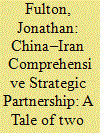

|
|
|
|
|
| Summary/Abstract |
The China-Iran comprehensive strategic partnership (CSP) has been described as a potentially disruptive alignment. This article analyses the impact of the CSP in two regional security complexes (RSCs): the Persian Gulf and South Asia. It finds that of the two RSCs, the China-Iran CSP has a greater likelihood of affecting the strategic landscape of the South Asian RSC as China seeks to contain India's power and influence. In the Persian Gulf, China's economically-motivated regional presence is supported by the maintenance of the status quo, and as a result the CSP is not likely to adversely affect that RSC.
|
|
|
|
|
|
|
|
|
|
|
|
|
|
|
|
| 3 |
ID:
162914
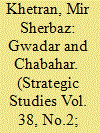

|
|
|
| 4 |
ID:
160455
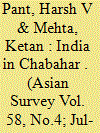

|
|
|
|
|
| Summary/Abstract |
Since the 1990s India has been committed to the completion of the Chabahar Port despite external and internal constraints that slowed the project’s development. This article explores the reasons behind Indian interest in the development of the Chabahar Port, and the challenges this project continues to face.
|
|
|
|
|
|
|
|
|
|
|
|
|
|
|
|
| 5 |
ID:
150170
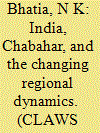

|
|
|
| 6 |
ID:
179035
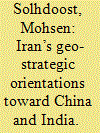

|
|
|
|
|
| Summary/Abstract |
Iran is pulled in different directions by China and India when it comes to their rivalry in economic and geopolitical spheres. Yet, Iran – which initially exploited the Sino-Indian rivalry to maximize its benefits following the 2015 nuclear deal – has strived to navigate ties between China and India to survive in the face of tough U.S. sanctions since 2018. This article, first, provides a brief discussion on historical precedents that have shaped Iran’s foreign policy in general. Then, the pivots of Iran-China-India triangular relationship are examined by looking at Iran’s a) involvement in China’s Belt and Road Initiative; b) partnership with China in the Iranian oil fields; c) participation in India’s International North-South Transport Corridor; and d) partnership with India in the Chabahar port. Finally, Iran’s reorientation in response to former President Trump’s withdrawal from the 2015 deal and its reaction to President Biden’s possible return to the deal are discussed.
|
|
|
|
|
|
|
|
|
|
|
|
|
|
|
|
| 7 |
ID:
160484
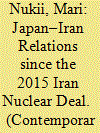

|
|
|
|
|
| Summary/Abstract |
The US–Japan alliance has been one of the most important elements in configuring Japanese diplomacy since World War II. Accordingly, Japan’s relations with Iran always require striking a delicate balance among Japan’s security policy based on the US–Japan alliance, its energy demands, and its historically good bilateral relations with Iran. Japan welcomed the nuclear deal between Iran and the P5+1 group of nations in 2015. Iran holds the world’s second largest natural gas reserves and ranks fourth in proven crude oil reserves. Japanese companies were eager to re-enter the Iranian market with its rich natural resources and over 80 million strong population. However, the inauguration of President Trump in January 2017 and his antagonistic stance toward Iran has slowed this move. The Japanese government has taken the initiative to improve relations with Iran after lifting its sanctions against that country, while trying to mitigate possible risks. This article aims to examine relations between Iran and Japan after the Iran nuclear deal from three aspects: economic relations, nuclear cooperation, and security.
|
|
|
|
|
|
|
|
|
|
|
|
|
|
|
|
| 8 |
ID:
169763
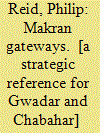

|
|
|
|
|
| Publication |
New Delhi, IDSA, 2019.
|
| Description |
45p.pbk
|
| Series |
IDSA Occasional Paper no; 53
|
| Standard Number |
9789382169857
|
|
|
|
|
|
|
|
|
|
|
|
Copies: C:2/I:1,R:0,Q:0
Circulation
| Accession# | Call# | Current Location | Status | Policy | Location | IssuedTo | DueOn |
| 059782 | 320.12/REI 059782 | Main | On Shelf | General | | | |
| 059783 | 320.12/REI 059783 | Main | Issued | General | | A1676 | 28-Oct-2023 |
|
|
|
|
| 9 |
ID:
190711
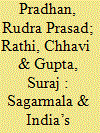

|
|
|
|
|
| Summary/Abstract |
Rejecting economic gradualism, Rosenstein-Rodan, back in 1943 advocated huge government-led initial infrastructure investment or ‘Big-Push Approach’ to achieve big economic growth. Welfare economists like Arthur Lewis and Rugnar Nursk expanded the proposition through their ‘Dual Sector Model’ and ‘Balanced Growth Approach’ converting the whole idea as a body of ‘Modernisation Theories’ for economic growth and development. John Maynard Keynes endorsed the idea too through his ‘Mixed Economy Growth Model’ prescription. Seaports are India’s trade and geo-economic gateways. India meanwhile has launched a very ambitious maritime modernization program called ‘Sagarmala 2015–2035’ to modernize Indian Seaports and develop port-led industrialization similar to Rodan’s Big Push approach. Seaports and their vessel traffic pattern provide critical insight into national maritime geo-economic outreach. In the background of India’s Sagarmala maritime modernization experience and similar lessons from the neighborhood, using Seaports vessel traffic as a variable, this article analyzes India’s maritime geo-economic comparative outreach and challenges.
|
|
|
|
|
|
|
|
|
|
|
|
|
|
|
|
| 10 |
ID:
169085
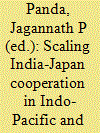

|
|
|
|
|
| Publication |
New Delhi, KW Publishers Pvt Ltd, 2020.
|
| Description |
xxxii, 331p.: figures, tables, maphbk
|
| Standard Number |
9789389137293
|
|
|
|
|
|
|
|
|
|
|
|
Copies: C:2/I:0,R:0,Q:0
Circulation
| Accession# | Call# | Current Location | Status | Policy | Location |
| 059759 | 327.54052/PAN 059759 | Main | On Shelf | General | |
| 059760 | 327.54052/PAN 059760 | Main | On Shelf | General | |
|
|
|
|
| 11 |
ID:
164124
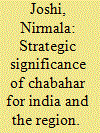

|
|
|
|
|
| Summary/Abstract |
As the globalising trend of the twenty first century gained a new momentum with trade and commerce and economic engagement among nations, the issue of connectivity projects also moved to the centre stage of international politics. What gave a further stimulus to connectivity projects was the opening of the vast Eurasian landmass after the break-up of the Soviet Union in 1991. The Eurasian space is extremely rich in natural resources and vital minerals, but the Eurasian landmass is landlocked. Eurasian region’s landlocked status spurred the construction of overland transport corridors in order to secure and if possible, to control the natural resources. The opening of this region also resulted in the reinvention of the British geographer Halford Mackinder’s theory of “Heartland of Eurasia” and the “Pivot of History”. In the process the world witnessed an evolving interplay of economics and geopolitics in Eurasia both by the developed and developing countries. In this context the connectivity issue acquired immense significance. It was one of the key issues on the agenda of those powers involved in Eurasia.
|
|
|
|
|
|
|
|
|
|
|
|
|
|
|
|
| 12 |
ID:
118492
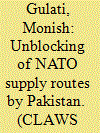

|
|
|